NCERT Class 11 Physics Chapter 7 notes System of Particles and Rotational Motion - Download PDF
Have you ever realised how a spinning wheel in a bicycle gradually comes to a halt when there is no more pedalling done? This observation alone is a beautiful expression of the laws of rotational motion and moment of inertia, which is the focus of Chapter 6 of Class 11 Physics Systems of Particles and Rotational Motion. The chapter develops an excellent conceptual ground in the study of the rotating motion of bodies, including important concepts like the centre of mass, torque, angular momentum, equilibrium of rigid bodies, and the laws of motion of rotation.
This Story also Contains
- NCERT Notes for Class 11 Physics Chapter 6: Download PDF
- System of Particles and Rotational Motion Class 11 Notes
- Class 11 Physics Chapter 6 System of Particles and Rotational Motion: Previous Year Question and Answer
- How to Master Class 11 Physics Chapter 6 System of Particles and Rotational Motion?
- Importance of Class 11 Physics Chapter 6 System of Particles and Rotational Motion Notes
- NCERT Class 11 Notes Chapter-Wise
- NCERT Books and Syllabus
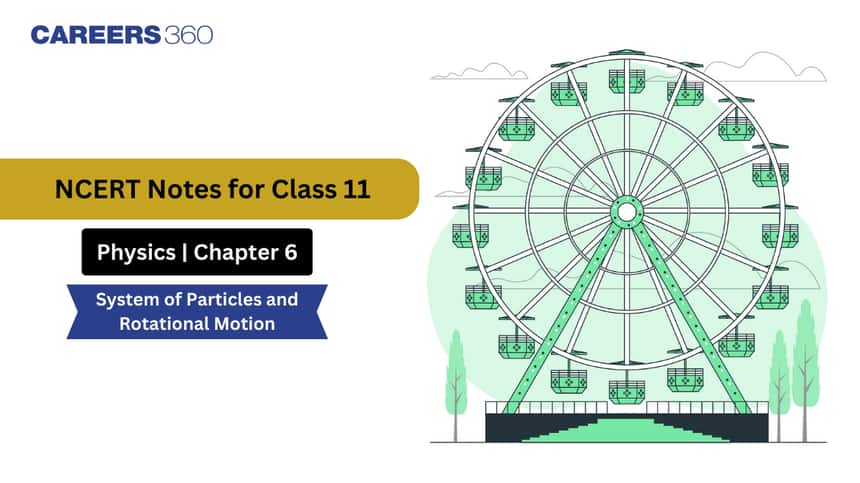
NCERT Notes for Class 11 Physics Chapter 6 System of Particles and Rotational Motion are prepared by the subject experts in order to simplify complex topics by explaining, following derivations in steps, and solving problems in brief. These Class 11 Physics Chapter 6 System of Particles and Rotational Motion Notes contain some crucial formulas, diagrams, and methods of solving problems, and thus, after reading these notes, students can learn even the hard concepts easily. Perfect in the preparation of both board exams in Class 11 of the CBSE curriculum and the competitive exams such as JEE and NEET, these NCERT notes are a useful source of quick revision and consolidation of knowledge on the subject of mechanics. These well-organised NCERT Notes for Class 11 Physics Chapter 6 System of Particles and Rotational Motion will help the students to develop a strong basis, increase their accuracy, and feel confident to deal with exam-level and conceptual questions.
Also, students can refer,
NCERT Notes for Class 11 Physics Chapter 6: Download PDF
Class 11 Physics Chapter 6 System of Particles and Rotational Motion Notes come in a well-organised and easy-to-download PDF format to enable students to study efficiently. These System of Particles and Rotational motion Class 11 Physics Chapter 6 CBSE notes have clear explanations, formulae, and examples that have been solved, and thus, a last-minute preparation is fast and efficient. The downloadable PDF makes access easy anytime, such that the students are able to reinforce their mastery and enhance their performance in examinations such as CBSE, JEE, and NEET.
System of Particles and Rotational Motion Class 11 Notes
The System of Particles and Rotational Motion Class 11 Physics Chapter 6 CBSE notes present an explanation of key physics concepts in a simplified form with a structured format. To simplify and shorten the revision time, these System of Particles and Rotational motion Class 11 Physics notes contain the summaries of the major derivations, formulas, and examples. Prepared in line with the current CBSE Class 11 Physics syllabus, they assist the students in enhancing clarity and being more precise in the context of preparing to take board as well as JEE/NEET exams.
Rotational Motion
- Rotational motion describes the movement of an object as it spins or revolves around an axis. Consider a spinning top, a rotating wheel, or the Earth turning on its axis; these are all examples of rotational motion.
- In this type of motion, each point in the object follows a circular path around a fixed line known as the axis. The motion is a rotation rather than a linear translation.
Centre of Mass
- The centre of mass is an imaginary point in a system where all of the system's mass is concentrated. When two bodies are joined, their centre of mass is along the line that connects them.
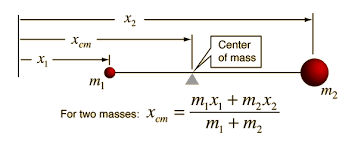
(Here, m1 & m2 are two bodies in which m1 is at a distance x1, & m2 at a distance x2 from the origin O).
- The coordinates of a system's centre of mass (X, Y, Z) are generally given by $\sum \frac{m_i \vec{r}_i}{m}$
- Considering a thin rod of length

-
The total contribution of each such integral and the integral x dm is zero. Therefore, the COM coincides with its geometric centre.
-
The centre of mass coincides with the geometric centre, and with the same geometry applies to homogenous rings, discs, spheres, or even thick rods of circular or rectangular cross-sections;
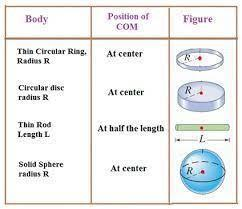
Motion of COM
- The centre of mass of a system of particles moves in a manner such that the entire mass of the system is considered to be concentrated at the centre, and all external forces are treated as if they act solely on that point.
$M \vec{R}=\sum m_i \overrightarrow{r_i}=m_1 \overrightarrow{r_1}+m_2 \overrightarrow{r_2}+\ldots \ldots m_n \overrightarrow{r_n}$
Differentiating w.r.t. time, we get,
$\begin{aligned} M \frac{\overrightarrow{d R}}{d t} & =m_1 \frac{\overrightarrow{d r_1}}{d t}+m_2 \frac{\overrightarrow{d r_2}}{d t}+\ldots \ldots m_n \frac{\overrightarrow{d r_n}}{d t} \\ M \vec{v} & =m_1 \overrightarrow{v_1}+m_2 \overrightarrow{v_2} \ldots \ldots+m_n \overrightarrow{v_n}\end{aligned}$
Again, differentiating w.r.t. time, we get,
$\begin{aligned} & M \vec{a}=m_1 \overrightarrow{a_1}+m_2 \overrightarrow{a_2} \ldots \ldots+m_n \overrightarrow{a_n} \\ & M \vec{a}=\overrightarrow{F_{\text {ext }}}\end{aligned}$
-
Instead of considering extended bodies as single particles, we can consider them as systems of particles.
- The translational component of their motion could be attained by taking the mass of the whole system and all the external forces on the system to be acting at the centre of mass.
Linear Momentum of a System of Particles
- The linear momentum of a system of particles is the product of the system's total mass and the velocity of its centre of mass. This relationship is expressed as follows:
- Linear Momentum = Total Mass × Velocity of Centre of Mass
$\begin{aligned}
&\begin{aligned}
& \vec{p}=\vec{p}_1+\vec{p}_2+\ldots+\vec{p}_n \\
& \vec{p}=\mathrm{m} 1 \vec{v}_1+\mathrm{m} 2 \vec{v}_2+\ldots+\mathrm{mn} \vec{v}_n \\
& \vec{p}=M \vec{v}
\end{aligned}\\
&\text { Where } \vec{p}=\text { Momentum particles and } \vec{v}=\text { Velocity of COM }
\end{aligned}$
- Newton's Second Law of Motion, in reference to the system of particles, is represented by the following expression:
$\frac{\overrightarrow{d p}}{d t}=\vec{F}_{e x t}$
-
In case when the total external force acting on a system of particles is zero $\left(\vec{F}_{\text {ext }}=0\right)$, then, in that case, the total linear momentum of the system is constant and can be represented as:
$(\frac{\overrightarrow{d p}}{d t}=0 ; \vec{p}=$ constant $)$
-
The Centre of mass having velocity also remains constant (Since $\vec{p}=m \vec{v}=$ Constant).
-
If the total external force on a body is zero, then the internal forces cause complex trajectories of individual particles in spite of the COM moving with a constant velocity.
Angular Velocity & Linear Velocity
- Each particle of a rotating body is considered to move in a circle. We define the angular displacement of a given particle about its centre in unit time as angular velocity.
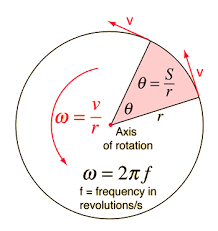
- Average angular velocity =∆θ/∆t
- Instantaneous angular velocity, ω=dθ/dt
- In a pure rotation motion, all the parts of the moving body have the same angular velocity.
- It is a vector quantity
- $\vec{v}=\vec{\omega} \times \vec{r}$; where $\vec{v}$ is the linear velocity of a particle and r is the radius of the circle.
- Angular acceleration is outlined as the rate of change of angular speed with respect to time. $\vec{\alpha}=\frac{\overrightarrow{d \omega}}{d t}$
Torque & Angular Momentum
- The rotational analogue of force is a moment of force, which is also known as Torque.
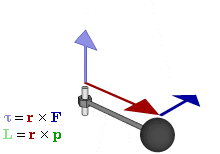
- Torque is a vector quantity.
Equilibrium of a Rigid Body
-
The translational state of the motion of the rigid body is due to the changes in force, i.e. its total linear momentum changes.
-
The rotational state of motion of the rigid body is due to the changes in torque, i.e. the total angular momentum of the body changes.
-
Unless stated otherwise, only external forces and torques should be dealt.
- A rigid body is said to be in mechanical equilibrium when both its linear momentum and angular momentum are constant with time. This means
Total force zero = Translational Equilibrium
Total torque zero = Rotational Equilibrium

- A couple or torque can be defined as a pair of equal and opposite forces with different lines of action is termed a couple or torque.
- Without translation, the couple can produce the rotation. For example, when you open the lid of a jar, you put a couple on it.
Centre of Gravity
- The centre of gravity of a body is the point on the body where the total gravitational torque on the body is zero.
- In uniform gravity or gravity-free space, the centre of gravity of the body coincides with the centre of mass.
- The condition for the centre of gravity and centre of mass will not coincide is that if the value of g varies from part to part of the body.
Moment of Inertia
- Moment of inertia (I) is the analogue of mass in rotational motion.
- A change in rotational motion is resisted by the moment of inertia about a given axis of rotation. It can be regarded as a measure of rotational inertia of the body.
- It is a measure of how the different parts of the body are distributed at different distances from the axis.
- The moment of inertia of a rigid body depends on the mass of the body, its form and size, and therefore the distribution of mass concerning the axis of rotation.
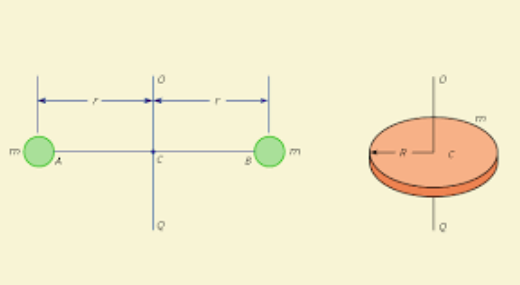
- The radius of gyration of a body with respect to an axis is defined as the distance from the axis of a mass whose mass is up to the mass of the total body and whose moment of inertia is up to the moment of inertia of the body concerning the axis.
I = Mk2, where k is the radius of gyration.
The Theorem of Perpendicular Axis
- Perpendicular Axis Theorem: The moment of inertia of a two-dimensional body (lamina) regarding an axis perpendicular to its plane is the sum of its moments of inertia regarding two perpendicular axes synchronous with the perpendicular axis and lying within the plane of the body.

- It is applicable only to planar bodies.
The Theorem of Parallel Axis
- Parallel Axis Theorem: The moment of inertia of a body about an axis parallel to an axis passing through the centre of mass is equal to the sum of the moment of inertia of the body about an axis passing through the centre of mass and the product of mass & square of the distance between the two axes. This theorem is applicable to a body of any form.


Kinematics of Rotational Motion for a Fixed Axis
We can derive equations of motion similar to translational motion.
Translational motion
v=vo+at
x=xo+vot+0.5at2
v2=vo2+2as
Rotational Motion
ω=ωo+αt
θ=θo+ωot+0.5αt2
ω2=ωo2+2αθ
Dynamics of Rotational Motion for a Fixed Axis
- The components of torques are considered along the direction of the fixed axis, and this is so because the component of the torque is perpendicular to the axis of rotation, and this will tend to turn the axis from its position.
- The forces that lie in planes perpendicular to the axis are only considered. Forces parallel to the axis give torques perpendicular to the axis.
- Also, the components of the position vectors which are perpendicular to the axis are only considered. Components of position vectors on the axis can lead to torques perpendicular to the axis.
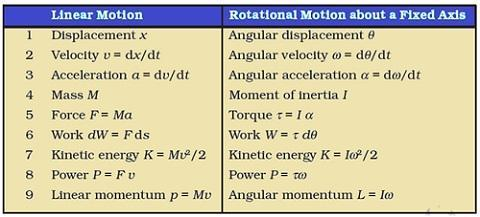
Class 11 Physics Chapter 6 System of Particles and Rotational Motion: Previous Year Question and Answer
System of Particles and Rotational Motion Previous Year Questions and Answers encourage students to have knowledge of the kind of questions that could be asked in board and competitive exams. These answered questions provide an understanding of some critical concepts, derivations, and numerical trends of previous papers. Their practice enhances the preparation for exams and confidence in achieving high marks in Class 11 Physics, JEE, and NEET.
Q1: The net external torque on a system of particles about an axis is zero. Which of the following are compatible with it?
a) The forces may be acting radially from a point on the axis
b) The forces may be acting on the axis of rotation
c) The forces may be acting parallel to the axis of rotation
d) The torque caused by some forces may be equal and opposite to that caused by other forces
Answer:
Torque is given by $\vec{\tau}=\vec{r} \times \vec{F}$
Or
$\tau=r F \sin \theta \hat{n}$ where $\theta$ is the angle between both the vectors and $\hat{n}$ is the unit vector perpendicular to the plane of $\vec{r}$ and $\vec{F}$
1. When the force is acting radially in the direction of $\vec{r}, \theta=0$
$\ tau=r F sin 0=0 $
2. $\text{When the forces are acting on the axis of rotation, then}$ $\theta=0$ $ \text{and thus}$ $\tau=0$
3. The component of forces in the plane of $\vec{r}$ and $\vec{F}$ when they are parallel to the axis of rotation is $F \cos 90^{\circ}$, which is equal to 0 . Hence $\tau=0$
4. When torques are equal in magnitude but opposite in direction, the net resultant is 0.
Hence, the answers are options (a) and (b).
Q2: A Merry-go-round, made of a ring-like platform of radius $R$ and mass $M$, is revolving with angular speed $\omega$
Answer:
As no external torque acts on the system, angular momentum should be conserved.
Hence. $I \omega=$ constant ,
where $I$ is the moment of inertia of the system and $\omega$ is the angular
velocity of the system.
From Eq. (i), $I_1 \omega_1=I_2 \omega_2$
(where $\omega_1$ and $\omega_2$ are angular velocities before and after jumping)
$
\Rightarrow I \omega=\frac{I}{2} \times \omega_2
$
(As mass is reduced to half, hence moment of inertia is also reduced to half)
$
\Rightarrow \omega_2=2 \omega
$
Q3: Which of the following points A, B and C is the likely position of the centre of mass of the system shown in Fig. 7.1?
Answer:
The volume of the hollow sphere is occupied equally by the air and sand. Since the pressure exerted by the air region is less than that of sand, the mass of sand is greater than the air. The centre of mass shifts towards a heavier portion, which in this case is sand. B is exactly at the line dividing air and sand, so it is incorrect. D is at the farthest end and divides the sand area very unequally, so it also cancels out. C is almost at the centre with regard to the mass.
How to Master Class 11 Physics Chapter 6 System of Particles and Rotational Motion?
One of the chapters in Class 11 Physics that has difficult concepts is Rotational Motion and System of Particles. It presents concepts such as centre of mass, rotational inertia, torque, and angular momentum, which are used many times again in Class 12 and JEE/NEET. Learning this chapter enables students to develop profound conceptual understanding and find high-level numerical problems with ease.
- Begin with basic exercises in centre of mass (COM), e.g. two-mass systems, or a rod; do exercises in locating the COM of different shapes.
- Understand what translational and rotational motion is and try to associate them with objects in the real world, such as spinning tops and rolling wheels.
- Practice questions having the formula of moment of inertia (I) with care and practice the applications of parallel axis and perpendicular axis theorems.
- Get a conceptual grasp of torque (t) and think of a way to use it, say to open a door, to use a wrench, before you answer theory questions.
- Derive and use equations of angular velocity, angular acceleration, and angular momentum. This is the foundation of the majority of numerical questions.
- Solve problems based on rolling motion, especially pure rolling conditions ($v = r\omega$), as these are frequently asked in competitive exams.
- Write down all common moments of inertia formulas of rod, ring, disc, sphere, and cylinder and revise them on a regular basis.
- Practice NCERT textbook problems, NCERT exemplar problems, and previous questions of the JEE Main so that you can be better at applying.
- Redraw and revise important graphs and drawings, e.g. rotation diagrams of rigid bodies and torque-angle diagrams.
- Prepare a short formula sheet for quick revision before exams to avoid confusion during numerical solving.
Importance of Class 11 Physics Chapter 6 System of Particles and Rotational Motion Notes
NCERT notes Class 11 Physics Chapter 6 System of Particles and Rotational Motion play an essential role in the foundation of good work on mechanics. They make complex concepts such as torque, angular momentum, and rotational dynamics easier to comprehend by presenting brief explanations and solved problems. The NCERT notes Class 11 Physics Chapter 6 System of Particles and Rotational motion allow students to understand theoretical and numerical knowledge effectively, and they are very useful in preparing for the CBSE examination, the JEE, and the NEET.
Clear Understanding of Fundamentals
- Systems of particles, centre of mass, and rotational motion are described in a simplified form by the NCERT Notes for Class 11 Physics Chapter 6, which allow students to construct a strong conceptual clarity.
Time-Saving for Revision
- Properly organised System of Particles and Rotational Motion Class 11 Notes save time when it comes to last-minute revision, as all the formulas, derivations, and important definitions are consolidated in a single location.
Increases Board Exam Prep
- These are the notes that are prepared in accordance with the recent NCERT syllabus, and they assist students in receiving higher marks in CBSE Class 11 Physics exams.
Competitive Exam Readiness
- These NCERT Notes for Class 11 Physics Chapter 6 notes are highly relevant for JEE Main, JEE Advanced, NEET, and other competitive exams, as topics like torque, angular momentum, and equilibrium frequently appear in the question papers.
Easy Formula Retention
- All significant formulae of rotational motion, moment of inertia, and centre of mass can be found, and students find it easy to revise and memorise.
Application-Based Learning
- NCERT Notes for Class 11 Physics Chapter 6 relate theory to applied applications such as the motion of planets, spinning objects, and rolling motion in real life, making learning more interactive.
Error-Free Learning Resource
- Since the notes are based on NCERT Class 11 Physics, students can trust them as authentic and reliable study material.
NCERT Class 11 Notes Chapter-Wise
NCERT Class 11 Notes Chapter-Wise contain brief, clearly organised and simple summaries of every chapter. These are notes on major concepts, formulas, derivations and diagrams as per the newest CBSE syllabus that enable students to revise quickly. They are of great utility in board exams and also in competitive exams as JEE and NEET.
Subject-Wise NCERT Exemplar Solutions
- NCERT Exemplar Class 11 Solutions
- NCERT Exemplar Class 11 Maths
- NCERT Exemplar Class 11 Physics
- NCERT Exemplar Class 11 Chemistry
- NCERT Exemplar Class 11 Biology
Subject-Wise NCERT Solutions
NCERT Books and Syllabus
Frequently Asked Questions (FAQs)
Rotational motion principles are used in:
- Vehicles (wheels, gears, and flywheels)
- Earth’s rotation (day and night cycle)
- Satellites & gyroscopes (stabilization)
- Sports (cricket, gymnastics, a
This chapter is a scoring topic in JEE, NEET, and CBSE board exams. It helps in solving complex physics problems involving motion, forces, and energy conservation.
Rolling motion is a combination of translational and rotational motion.
Pure rolling occurs when there is no slipping, and v = Rω (where v is linear velocity, R is radius, and ω is angular velocity).
If no external torque acts on a system, angular momentum (L = Iω) remains constant. This principle explains why a skater spins faster when pulling in their arms.
The moment of inertia (I) is the rotational equivalent of mass. It represents an object's resistance to angular acceleration and depends on mass distribution.
Popular Questions
Courses After 12th
Applications for Admissions are open.
As per latest syllabus. Physics formulas, equations, & laws of class 11 & 12th chapters
JEE Main Important Chemistry formulas
Get nowAs per latest syllabus. Chemistry formulas, equations, & laws of class 11 & 12th chapters
JEE Main high scoring chapters and topics
Get nowAs per latest 2024 syllabus. Study 40% syllabus and score upto 100% marks in JEE
JEE Main Important Mathematics Formulas
Get nowAs per latest syllabus. Maths formulas, equations, & theorems of class 11 & 12th chapters

